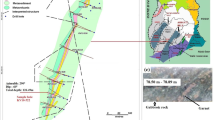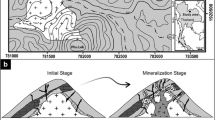Abstract
The mineralogy and geochemistry of the waste rocks distributed at Taojiang Mn-ore deposit, central Hunan province, China, were studied using X-ray powder diffraction (XRD), electron microprobe analysis (EMPA) fitted with energy dispersive spectrometer (EDS) and inductively coupled plasma mass spectrum (atomic emission spectra) ICP-MS (AES), with the aim of predicting the environmental impacts of weathering of the waste rocks. The mineralogical results from microscope observation and XRD and EMPA studies show that the waste rock is composed of black shale and minor Mn carbonates. The oxidation of sulfide minerals such as galena, pyrite and chalcopyrite is accompanied by decomposition of Mn carbonates and K-feldspar during exposure to atmospheric O2. The geochemical characteristics of major, rare earth elements (REE) and trace elements of the waste rocks also show that the waste rock can be divided into black shale and Mn carbonate, and both of them are currently under chemical weathering. The major alkalies and alkaline elements (Ca, Mg, Na, K, Rb, Sr and Cs) and major elements (Fe, S and P) and heavy metals (Sc, V, Cr, Th, U, Sn, Co, Ni, Cu, Zn, Pb, Mo, Cd, Sb, an Tl) are being released during weathering. The mobility of alkalis and alkaline elements Ca, Mg, Na, K, Rb, Sr and Cs is controlled by decomposition of Mn carbonates. The dispersion of Cr, Sc and Th (U) might be related to weathering of K-feldspar, and the release of the heavy metals Co, Ni, Cu, Zn, Pb, Mo, Cd Sb and Tl is dominated by the breaking of sulfide minerals. The REE of the waste rocks and surrounding soils and the spidery distribution patterns of heavy metals in the waste rocks, the surrounding soils and the surface waters show that weathering of the waste rocks and bedrock might be the sources of heavy metal contamination for the surrounding soils and surface water system for the mining area. This is predicted by the mass-balance calculation by using Zr as an immobile element. Therefore, it is urgently necessary take measures to treat the waste rocks distributed throughout the area for the local environmental protection.








Similar content being viewed by others
References
Akpan ER, Ekpe UJ, Ibok UJ (2002) Heavy metal trends in the Calabar River, Nigeria. Environ Geol 42:47–51
Audry S, Blance G, Schafer J (2005) The impact of sulphide oxidation on dissolved metal (Cd, Zn, Cu, Cr, Co, Ni, U) inputs into the Lot-Garonne fluvial system (France). Appl Geochem 20:919–931
Bhatia MR (1983) Plate tectonics and geochemistry composition of sandstones. J Geol 91:611–627
Blowes DW, Jambor JL, Hanton-Fong CJ (1998) Geochemical, mineralogical and microbiological characetristion of a sulphide-bearing carbonate-rich gold-mine tailings impoundment, Joutel, Quebec. Appl Geochem 13(6):687–705
Boulet M, Larcoque ACL (1998) A comparative mineralogical and geochemical study of sulfide mine tailings at sites in New Mexico, USA. Environ Geol 33:130–142
Bowen HJM (1979) Plants and chemical elements. Academic, London
Chon HT, Cho CH, Kim KW, Moon HS (1996) The occurrence and dispersion of potentially toxic elements in areas covered with black shales and slates in Korea. Appl Geochem 11:69–76
Coveney RM Jr, Grauch RI, Murowchick JB (1994) Metals, phosphate and stone coal in the Proterozoic and Cambrian of China. SEG Newsl 18:1–11
Dold B, Fontbote L (2002) A mineralogical and geochemical study of element mobility in sulfide mine tailings of Fe oxide Cu–Au deposits from the Punta del Cobre belt, north Chile. Chem Geol 189:135–163
Emsbo P, Hofstra AH, Johnson CA, Koenig A, Grauch R, Zhang XC, Hu RZ, Su WC, Pi DH (2005) Lower Cambrian metallogenesis of south China: interplay between diverse basinal hydrothermal fluids and marine chemistry. In: Mao JW, Bierlein FP (eds) Mineral research: meeting the global challenge, vol 1. Springer, Berlin Heidelberg New York. pp 115–118
Evangelou VP, Huang X (1994) Infrared spectroscopy evidence of an iron carbonate complex on the surface of pyrite. Spectrochim Acta 50(A):1333
Fan DL, Zhang T, Ye J (2004) The black shales distributed in China and their relative ore deposits. Science Press, Beijing, pp 260–343 (in Chinese)
Fanani L, Zuddas P, Chessa A (1997) Heavy metals speciation analysis as a tool for studying mine tailings weathering. J Geochem Explor 58:241–248
Feng R, Kerrich R (1990) Geochemistry of fine-grained clastic sediments in the Archean Abitibi greenstone belt, Canada: implications for provenance and tectonic setting. Geochim et Cosmochim Acta 54:1061–1081
Frostner U, Wittman GTW (1981) Metal pollution in the aquatic environment, 2nd edn. Springer, Berlin Heidelberg New York
Fu QH (2001) The geological and geochemical characteristics of Taojiangtype manganese deposits. Hunan Geol 20(1):15–20
Holmstrom H, Ljungberg J, Ohlander B (1999) Role of carbonates in mitigation of metal release from mining waste, evidence from humidity cells tests. Environ Geol 37(4):267–280
Jaffe LA, Peucker-Ehrenbrink B, Petsch ST (2002) Mobility of rhenium, platinum group elements and organic carbon during black shale weathering. Earth Planet Sci Lett 198:339–353
Jiang DH, Yang ZQ, Zhao SJ (1995) Studies of ore-forming process of “Taojiang type manganese” of the middle Ordovician in central Hunan province. Acta Sedimentologica Sinica 13(1):59–67 (in Chinese with English abstract)
Jung BH, Yun ST, Mayer B, Kim SO, Park SS, Lee PK (2005) Transport and sediment-water partitioning of trace metals in acid mine drainage: an example from the abandoned Kuangyang Au-Ag mine area, South Korea. Environ Geol 48:437–449
Kuang OG, Zhao YH, Wu YS, Li YL (2003) Effects of structural controlling on spatial distribution of the “Taojiang style” manganese deposits. Geol Prospect 39(1):32–35 (in Chinese with English abstract)
Kurtz AC, Derry LA, Chadwick OA, Alfano MJ (2000) Refractory element mobility in volcanic soils. Geology 28:683–686
Lakhan VC, Cabana K, LaValle PD (2002) Heavy metal concentrations in superficial sediments from accreting and eroding areas along the coast of Guyana. Environ Geol 42:73–80
Lapakko K, Antonson DA, Wanger JR (1997) Mixing of limestone with finely-crushed acid producing rock. ICARD, Vancouver, pp 1345–1360
Larocque AC, Rasmussen PE (1998) An overview of trace metals in the environment, from mobilization to remediation. Environ Geol 33(2/3):85–90
Lavergren U (2005) Black shales as a metal contamination source. ESS Bull 3(1):18–31 (from website: http://www.bom.hik.se/ess)
Li J, Zheng CJ (1988) Handbook for background values of elements in environments. China Environmental Science Press, China, pp 123–238 (in Chinese)
Lu L, Wang RC, Chen FR, Xue JY, Zhang PH, Lu JJ (2005) Element mobility during pyrite weathering: implications for acid and heavy metal pollution at mining-impacted sites. Environ Geol 49:82–89
Malmstrom ME, Gleisner M, Herbert RB (2006) Element discharge from pyretic mine tails at limited oxygen availability in column experiments. Appl Geochem 21:184–202
Mason B, Morre CB (1982) Principles of geochemistry, 4th edn. Wiley, New York, pp 46, 47, 176–177
McLennan SM, Taylor SR, McCulloch MT, Maynard JB (1983) Geochemistry of Archean shales from the Pilbarab Supergroup, western Australia. Geochim Cosmochim Acta 47:1211–1222
Middelburg JJ, Weijden CV, Woittiez JRW (1988) Chemical processes affecting the mobility of major, minor and trace elements during weathering of granitic rocks. Chem Geol 68:253–273
Moncur MC, Ptacek CJ, Blowes DW, Jambor JL (2005) Release, transport and attenuation of metals from an old tailings impoundment. Appl Geochem 20:639–659
Neaman A, Flore M, Trolard F, Borrie G (2004) Improved methods for selective dissolution of Mn oxides: applications for studying trace element associations. Appl Geochem 19:973–979
Nesbitt HW, Muir IJ (1994) X-ray photoelectron spectroscopic study of pristine pyrite surface reacted with water vapour and air. Geochim Coschim Acta 58:4667–4679
Nesbitt HW, Wilson RE (1992) Recent chemical weathering of basalts. J Sci 292:740–777
Nesbitt HW, Markovics G, Price RC (1980) Chemical processes affecting alkalis and alkaline earths during continent weathering. Geochim Cosmochim Acta 44:1659–1666
Nestbitt WH (1979) Mobility and fractionation of rare earth elements during weathering of a granodiorite. Nature 279:206–210
Nurnberg HW (1984) The voltammertric approach in trace metal chemistry of natural waters and atmospgeric precipitation. Anal Chem Acta 164:1–21
Pasava J, Kribek B, Zak K, Li C, Deng HL, Zeng M (2003) Preliminary results of the study of toxic elements in soils and crop plants in areas of Ni–Mo black shale-hosted deposits (Zunyi region, south China). In: Eliopoulos et al. (eds) Mineral exploration and substantial development, Millpress, Rotterdam, pp 53–56
Peng B, Song ZL, Tu XL, Lv HZ, Wu FC (2004) Release of heavy metals during weathering of the Lower Cambrian black shales in western Hunan, China. Environ Geol 45(8):1137–1147
Peng B, Wu FC, Xiao ML, Xie SR, Lu HZ, Dai YN (2005) The resource functions and environment effects of black shales. Bull Mineral Petrol Geochem 24(2):153–158 (in Chinese with English abstract)
Petsch ST, Berner RA, Eglinton TI (2000) A field study of the chemical weathering of ancient organic matter. Org Geochem 31:475–487
Peucker-Ehrenbrink B, Hannigan R (2000) Effects of black shale weathering on mobility of rhenium and platinum group elements. Geology 28:475–478
Rao XF, Fan DL (1990) Petrology and geochemistry of black shales of the middle Ordovician in Taojiang, central Hunan. Acta Petrol Sinica 3:78–86 (in Chinese with English abstract)
Silva EF, Zhang CS, Pinto LS, Patinha C, Reis P (2004) Hazard assessment on arsenic and lead in soils of Castromil gold mining area, Portugal. Appl Geochem 19:887–898
Sun CS (1995) Exploitation for poor and thin manganese resource in the Taojiang manganese mine. Hunan Geol 14(3):187–189 (in Chinese with English abstract)
Talyor SR, Mclennan SM (1995) Geochemical evolution of the continent crust. Rev Geophys 33:241–265
Wu YS, Cao JL (2003) Geochemistry traits of high grade Mn-ores of the middle Ordocician epoch in central Hunan. Hunan Geol 22(2):101–106 (in Chinese with English abstract)
Zhang LC, Yu ZS, Zhang S (1996) Chemical elements in aquatic environments. China Environmental Press, China, pp 190–194
Zhu SQ (1996) Characteristics of Taojiang-type hydrothermal sedimentary manganese deposits. Geol Rev 42(5):397–404 (in Chinese with English abstract)
Zhu KJ, Yao GL, Huang JH (1998) The geochemical process of Mn ore-capping in Taojiang manganese deposit. Geol Explor 13(3):1–8 (in Chinese with English abstract)
Acknowledgments
This study was supported by the National Scientific Foundation Committee of China grant number 40572172 and 40002021. We are grateful to MSc Latkiewicz at the Institute of Geological Science, Jagiellonian University (Poland), for help the EDS study. Mr. Xianglin Tu at the Guangzhou Institute of Geochemistry (CAS) is thanked for help for the ICP-MS/AES analyses. The authors wish to thank Dr. G. Beardsmore at Monash University, Australia, for improving the English language of the manuscript and Dr. T. F. Zhou for an official review.
Author information
Authors and Affiliations
Corresponding author
Rights and permissions
About this article
Cite this article
Peng, B., Piestrzynski, A., Pieczonka, J. et al. Mineralogical and geochemical constraints on environmental impacts from waste rock at Taojiang Mn-ore deposit, central Hunan, China. Environ Geol 52, 1277–1296 (2007). https://doi.org/10.1007/s00254-006-0567-8
Received:
Accepted:
Published:
Issue Date:
DOI: https://doi.org/10.1007/s00254-006-0567-8




